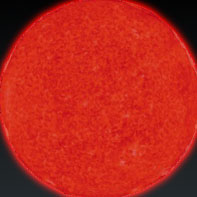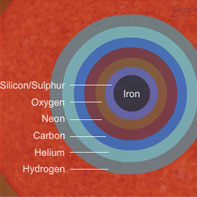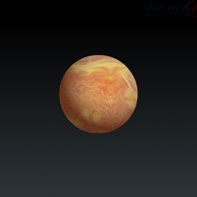Death of High Mass Stars
High mass stars are those with a mass greater than 3 solar masses or in other words three time more massive than our sun. Although these stars have more hydrogen fuel to consume the sequence of events is much faster. The hydrogen burning takes place at a high rate to maintain the pressures to counteract the gravitational attractive forces. This results in the stars attaining higher temperatures and appearing brighter than low mass stars.
The animation below shows the death of a high mass star.
High Mass Star |
 High mass stars are those with a mass greater than 3 solar masses or in other words three time more massive than our sun. Although these stars have more hydrogen fuel to consume the sequence of events is much faster. The hydrogen burning takes place at a high rate to maintain the pressures to counteract the gravitational attractive forces. This results in the stars attaining higher temperatures and appearing brighter than low mass stars. High mass stars are those with a mass greater than 3 solar masses or in other words three time more massive than our sun. Although these stars have more hydrogen fuel to consume the sequence of events is much faster. The hydrogen burning takes place at a high rate to maintain the pressures to counteract the gravitational attractive forces. This results in the stars attaining higher temperatures and appearing brighter than low mass stars.
|
Red Supergiant |
 For a high mass star, after the hydrogen and helium run out, the star cools and contracts under the influence of the gravitational forces and the nuclear fusion cycle in these stars continues. The gravitational potential energy from the mass of the star causes extremely high temperatures (about 170 million degrees Celsius) to build up in the core. This triggers further nuclear fusion of heavier elements causing the outer layer of the star to expand to about 100 times its original diameter forming a red supergiant. A red supergiant can have a radii 1500 times that of our sun. Due to the expansion of the outer layers the energy from the hydrogen layer is spread over a larger surface area resulting in a lower surface temperature and a shift in the stars light output to a red wavelength. For a high mass star, after the hydrogen and helium run out, the star cools and contracts under the influence of the gravitational forces and the nuclear fusion cycle in these stars continues. The gravitational potential energy from the mass of the star causes extremely high temperatures (about 170 million degrees Celsius) to build up in the core. This triggers further nuclear fusion of heavier elements causing the outer layer of the star to expand to about 100 times its original diameter forming a red supergiant. A red supergiant can have a radii 1500 times that of our sun. Due to the expansion of the outer layers the energy from the hydrogen layer is spread over a larger surface area resulting in a lower surface temperature and a shift in the stars light output to a red wavelength.
|
Red Supergiant Interior |
 The reason for nuclear fusion after hydrogen and helium is because the gravitational potential energy from the mass of the star causes extremely high temperatures to build up deep in the interior of the star giving the nuclei greater kinetic energy. They can overcome their mutual electrostatic repulsion allowing heavier elements such as carbon to undergo nuclear fusion to produce oxygen, neon, silicon, sulphur and finally iron. Iron has the most stable nucleus of nuclear matter; no further energy can be gained from its fusion. The reason for nuclear fusion after hydrogen and helium is because the gravitational potential energy from the mass of the star causes extremely high temperatures to build up deep in the interior of the star giving the nuclei greater kinetic energy. They can overcome their mutual electrostatic repulsion allowing heavier elements such as carbon to undergo nuclear fusion to produce oxygen, neon, silicon, sulphur and finally iron. Iron has the most stable nucleus of nuclear matter; no further energy can be gained from its fusion.
|
Supernova |
 With no further nuclear reactions supplying heat energy to push outwards and balance the immense gravitational forces, the star begins to collapse. After the end of the nuclear burning stage if the mass of the star is greater than 1.4 solar masses and less than 3 solar masses, further collapse of the iron core continues under the immense force of gravity. The gravitational forces are so strong that they provide enough force for the iron nuclei to overcome their electrostatic forces to become a rigid high density core. The formation of this rigid core happens rapidly. The collapse of the star is dramatically halted and the infalling material bounces off the core and up towards the star’s surface. This sudden bounce produces a shockwave of tremendous energy ejecting material and high energy particles (neutrinos) at high speeds. This massive explosion is called a supernova and during this short period the supernova can outshine a whole galaxy. It is from supernovae that the heavier elements such as carbon and oxygen are present in the universe. With no further nuclear reactions supplying heat energy to push outwards and balance the immense gravitational forces, the star begins to collapse. After the end of the nuclear burning stage if the mass of the star is greater than 1.4 solar masses and less than 3 solar masses, further collapse of the iron core continues under the immense force of gravity. The gravitational forces are so strong that they provide enough force for the iron nuclei to overcome their electrostatic forces to become a rigid high density core. The formation of this rigid core happens rapidly. The collapse of the star is dramatically halted and the infalling material bounces off the core and up towards the star’s surface. This sudden bounce produces a shockwave of tremendous energy ejecting material and high energy particles (neutrinos) at high speeds. This massive explosion is called a supernova and during this short period the supernova can outshine a whole galaxy. It is from supernovae that the heavier elements such as carbon and oxygen are present in the universe.
|
Neutron Star |
 After the supernova explosion, the remaining core is a neutron star. A neutron star is made up of tightly packed neutrons. Neutron stars have a diameter of about 12 to 30 miles in which they pack a mass 1.4 times that of our sun. Thus neutron stars are incredibly dense. On teaspoon of neutron star material would weigh a billion tons on Earth. A neutron star consists of a superfluid gas of tightly packed neutrons surrounded by a solid lattice of neutron rich nuclei, which is further surrounded by an iron crust. The high density of the neutron star means it also has a very high surface gravity, some 100 billion times more than that on the Earth. This results in the neutron star having a very smooth surface. After the supernova explosion, the remaining core is a neutron star. A neutron star is made up of tightly packed neutrons. Neutron stars have a diameter of about 12 to 30 miles in which they pack a mass 1.4 times that of our sun. Thus neutron stars are incredibly dense. On teaspoon of neutron star material would weigh a billion tons on Earth. A neutron star consists of a superfluid gas of tightly packed neutrons surrounded by a solid lattice of neutron rich nuclei, which is further surrounded by an iron crust. The high density of the neutron star means it also has a very high surface gravity, some 100 billion times more than that on the Earth. This results in the neutron star having a very smooth surface.
|
Pulsars |
 A neutron star has a very strong magnetic field. This is because the magnetic field of the original star is concentrated over a much smaller surface area. The surface of a neutron star contains a large number of protons and electrons. These particles are accelerated towards the magnetic poles gaining energy which is emitted as narrow beams of electromagnetic radiation from radio through to gamma rays. In addition the neutron star rotates rapidly in order to conserve its angular momentum from when it was of the radius of the original star. As the star rotates the beams of radiation sweep round like the beams of light from a lighthouse, such neutron stars are called pulsars a name derived from the words pulsating radio sources. The beams from pulsars can be detected as regular electromagnetic pulses on Earth based radio telescopes. A neutron star has a very strong magnetic field. This is because the magnetic field of the original star is concentrated over a much smaller surface area. The surface of a neutron star contains a large number of protons and electrons. These particles are accelerated towards the magnetic poles gaining energy which is emitted as narrow beams of electromagnetic radiation from radio through to gamma rays. In addition the neutron star rotates rapidly in order to conserve its angular momentum from when it was of the radius of the original star. As the star rotates the beams of radiation sweep round like the beams of light from a lighthouse, such neutron stars are called pulsars a name derived from the words pulsating radio sources. The beams from pulsars can be detected as regular electromagnetic pulses on Earth based radio telescopes.
|

 High mass stars are those with a mass greater than 3 solar masses or in other words three time more massive than our sun. Although these stars have more hydrogen fuel to consume the sequence of events is much faster. The hydrogen burning takes place at a high rate to maintain the pressures to counteract the gravitational attractive forces. This results in the stars attaining higher temperatures and appearing brighter than low mass stars.
High mass stars are those with a mass greater than 3 solar masses or in other words three time more massive than our sun. Although these stars have more hydrogen fuel to consume the sequence of events is much faster. The hydrogen burning takes place at a high rate to maintain the pressures to counteract the gravitational attractive forces. This results in the stars attaining higher temperatures and appearing brighter than low mass stars.  For a high mass star, after the hydrogen and helium run out, the star cools and contracts under the influence of the gravitational forces and the nuclear fusion cycle in these stars continues. The gravitational potential energy from the mass of the star causes extremely high temperatures (about 170 million degrees Celsius) to build up in the core. This triggers further nuclear fusion of heavier elements causing the outer layer of the star to expand to about 100 times its original diameter forming a red supergiant. A red supergiant can have a radii 1500 times that of our sun. Due to the expansion of the outer layers the energy from the hydrogen layer is spread over a larger surface area resulting in a lower surface temperature and a shift in the stars light output to a red wavelength.
For a high mass star, after the hydrogen and helium run out, the star cools and contracts under the influence of the gravitational forces and the nuclear fusion cycle in these stars continues. The gravitational potential energy from the mass of the star causes extremely high temperatures (about 170 million degrees Celsius) to build up in the core. This triggers further nuclear fusion of heavier elements causing the outer layer of the star to expand to about 100 times its original diameter forming a red supergiant. A red supergiant can have a radii 1500 times that of our sun. Due to the expansion of the outer layers the energy from the hydrogen layer is spread over a larger surface area resulting in a lower surface temperature and a shift in the stars light output to a red wavelength. The reason for nuclear fusion after hydrogen and helium is because the gravitational potential energy from the mass of the star causes extremely high temperatures to build up deep in the interior of the star giving the nuclei greater kinetic energy. They can overcome their mutual electrostatic repulsion allowing heavier elements such as carbon to undergo nuclear fusion to produce oxygen, neon, silicon, sulphur and finally iron. Iron has the most stable nucleus of nuclear matter; no further energy can be gained from its fusion.
The reason for nuclear fusion after hydrogen and helium is because the gravitational potential energy from the mass of the star causes extremely high temperatures to build up deep in the interior of the star giving the nuclei greater kinetic energy. They can overcome their mutual electrostatic repulsion allowing heavier elements such as carbon to undergo nuclear fusion to produce oxygen, neon, silicon, sulphur and finally iron. Iron has the most stable nucleus of nuclear matter; no further energy can be gained from its fusion. With no further nuclear reactions supplying heat energy to push outwards and balance the immense gravitational forces, the star begins to collapse. After the end of the nuclear burning stage if the mass of the star is greater than 1.4 solar masses and less than 3 solar masses, further collapse of the iron core continues under the immense force of gravity. The gravitational forces are so strong that they provide enough force for the iron nuclei to overcome their electrostatic forces to become a rigid high density core. The formation of this rigid core happens rapidly. The collapse of the star is dramatically halted and the infalling material bounces off the core and up towards the star’s surface. This sudden bounce produces a shockwave of tremendous energy ejecting material and high energy particles (neutrinos) at high speeds. This massive explosion is called a supernova and during this short period the supernova can outshine a whole galaxy. It is from supernovae that the heavier elements such as carbon and oxygen are present in the universe.
With no further nuclear reactions supplying heat energy to push outwards and balance the immense gravitational forces, the star begins to collapse. After the end of the nuclear burning stage if the mass of the star is greater than 1.4 solar masses and less than 3 solar masses, further collapse of the iron core continues under the immense force of gravity. The gravitational forces are so strong that they provide enough force for the iron nuclei to overcome their electrostatic forces to become a rigid high density core. The formation of this rigid core happens rapidly. The collapse of the star is dramatically halted and the infalling material bounces off the core and up towards the star’s surface. This sudden bounce produces a shockwave of tremendous energy ejecting material and high energy particles (neutrinos) at high speeds. This massive explosion is called a supernova and during this short period the supernova can outshine a whole galaxy. It is from supernovae that the heavier elements such as carbon and oxygen are present in the universe. After the supernova explosion, the remaining core is a neutron star. A neutron star is made up of tightly packed neutrons. Neutron stars have a diameter of about 12 to 30 miles in which they pack a mass 1.4 times that of our sun. Thus neutron stars are incredibly dense. On teaspoon of neutron star material would weigh a billion tons on Earth. A neutron star consists of a superfluid gas of tightly packed neutrons surrounded by a solid lattice of neutron rich nuclei, which is further surrounded by an iron crust. The high density of the neutron star means it also has a very high surface gravity, some 100 billion times more than that on the Earth. This results in the neutron star having a very smooth surface.
After the supernova explosion, the remaining core is a neutron star. A neutron star is made up of tightly packed neutrons. Neutron stars have a diameter of about 12 to 30 miles in which they pack a mass 1.4 times that of our sun. Thus neutron stars are incredibly dense. On teaspoon of neutron star material would weigh a billion tons on Earth. A neutron star consists of a superfluid gas of tightly packed neutrons surrounded by a solid lattice of neutron rich nuclei, which is further surrounded by an iron crust. The high density of the neutron star means it also has a very high surface gravity, some 100 billion times more than that on the Earth. This results in the neutron star having a very smooth surface. A neutron star has a very strong magnetic field. This is because the magnetic field of the original star is concentrated over a much smaller surface area. The surface of a neutron star contains a large number of protons and electrons. These particles are accelerated towards the magnetic poles gaining energy which is emitted as narrow beams of electromagnetic radiation from radio through to gamma rays. In addition the neutron star rotates rapidly in order to conserve its angular momentum from when it was of the radius of the original star. As the star rotates the beams of radiation sweep round like the beams of light from a lighthouse, such neutron stars are called pulsars a name derived from the words pulsating radio sources. The beams from pulsars can be detected as regular electromagnetic pulses on Earth based radio telescopes.
A neutron star has a very strong magnetic field. This is because the magnetic field of the original star is concentrated over a much smaller surface area. The surface of a neutron star contains a large number of protons and electrons. These particles are accelerated towards the magnetic poles gaining energy which is emitted as narrow beams of electromagnetic radiation from radio through to gamma rays. In addition the neutron star rotates rapidly in order to conserve its angular momentum from when it was of the radius of the original star. As the star rotates the beams of radiation sweep round like the beams of light from a lighthouse, such neutron stars are called pulsars a name derived from the words pulsating radio sources. The beams from pulsars can be detected as regular electromagnetic pulses on Earth based radio telescopes.